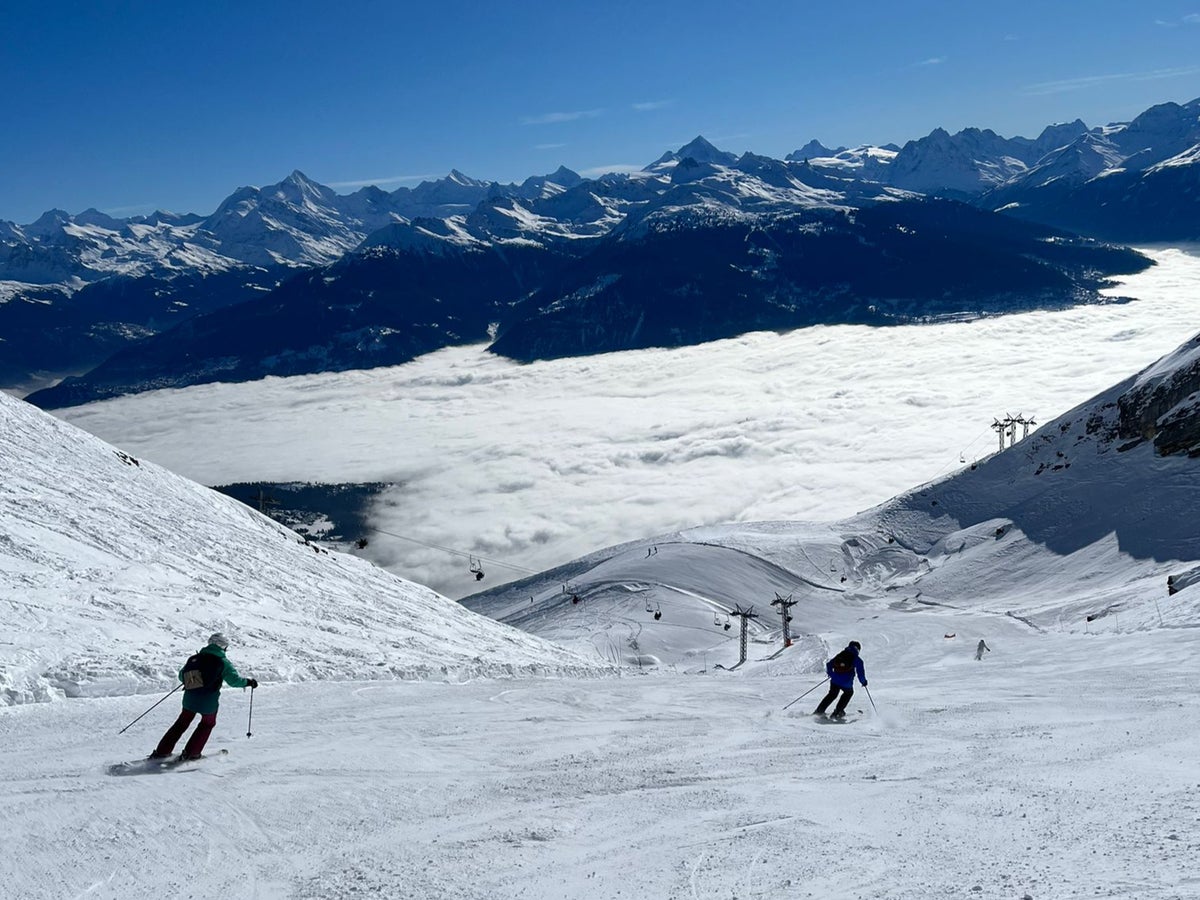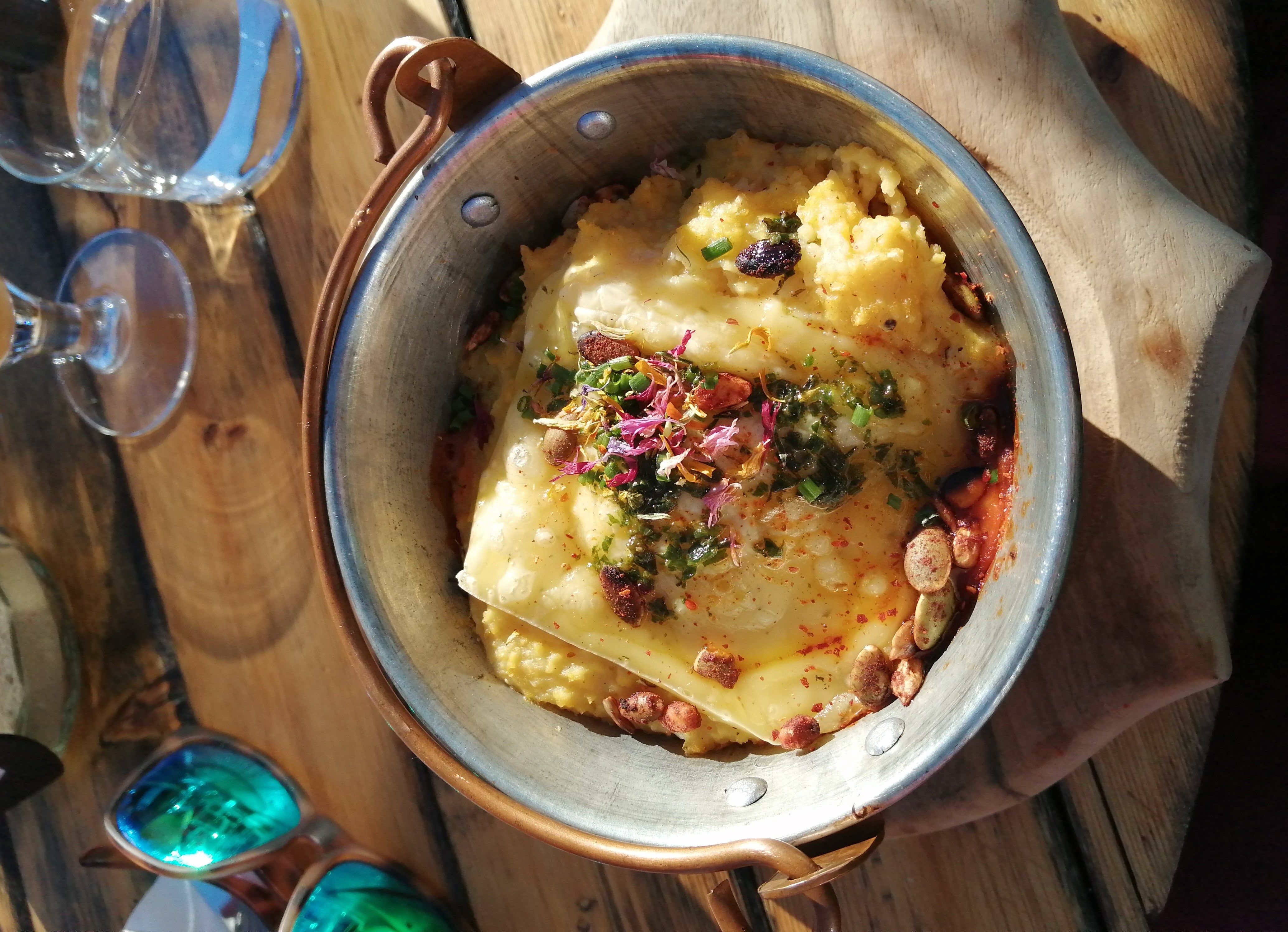
Travel Positive is a new column where we celebrate the exciting sustainability wins in the travel industry that are giving us hope for the future.
Sitting on a sun-drenched terrace with a local beer in hand and a raclette dish before me, gazing across the majesty of the Valais and the snow-smothered Swiss Alps, I feel the same bone-deep sense of contentment I always do in the mountains. It’s why I keep coming back, year after year, to don uncomfortable boots, clip them into planks of wood, and hurl myself downhill at speeds I pray to God my mother never finds out about.
But increasingly that contentment has been tainted by something else: a tiny, niggling question of whether, in attempting to enjoy the beauty of the Alps, I could be part of the reason they’re gradually being degraded. That my actions, along with thousands of others’, could be the very thing that’s jeopardising the future of these unparalleled landscapes.
We all saw the photos from ski resorts across Europe this season – pistes usually cloaked in white reduced to narrow strips on brown slopes, as an unseasonably mild winter and dearth of snowfall led to closed lifts and runs. It served as a visual, visceral warning: climate change is not some future, far-off event. It is already here, reshaping the way our world looks and functions.

At the time, a friend shared a Private Eye cartoon of lots of planes in the sky. One speech bubble read, “Dammit, there’s no snow for skiing?!”; another replied, “What rotten luck!”. It seemed to succinctly sum up the problem: there’s still a huge disconnect between our own emissions-heavy behaviour and the impact that might be having on our planet and, consequently, the elements we love most about it.
But does it have to be this way? Does taking a ski trip always have to be a high-carbon activity? Not according to Ed Hopkins, director of sustainability-focused PR firm Dark Green, who has taken it upon himself to organise what’s been billed as the “world’s most sustainable ski trip”. Hence why I’m sitting on this restaurant terrace in the small but perfectly formed Swiss resort of Anzère, tucking into no ordinary raclette – this one is strictly vegan, the melted “cheese” topping a warming bowl of roasted tomato ragout and polenta.
Before I get anywhere near that mountainside lunch though, there’s the small matter of getting there from the UK. Herein lies the biggest factor when it comes to Brits taking ski holidays – the vast majority will fly (72 per cent, according to a survey by the Ski Club of Great Britain), and it is this that makes up the highest proportion of carbon emissions for any snowsports trip. According to a study by the French ski areas of La Clusaz, Le Grand Bornand and Tignes, 52 per cent of your carbon cost will be generated by travel to resort; that number rises to around 95 per cent if you’re flying long-haul to ski in the US, for example.
There’s still a huge disconnect between our own emissions-heavy behaviour and the impact that might be having on our planet
“The single biggest way you can make a difference to the carbon footprint of your holiday is in how you choose to travel to resort,” says Iain Martin of Ski Flight Free, a campaign to encourage skiers to travel to the Alps without flying. “Typically this adds up to 50-70 per cent of the total carbon cost of the holiday – simply because most people choose to fly. Travelling by train is best option – reducing your emissions to around 1/8 of flying – though if you can travel in a car with at least four people in it that also makes a significant difference.”
Thus it is that my merry band of fellow sustainable skiers and I find ourselves blearily heading out of St Pancras early on a Wednesday morning to Paris on the first of the day’s four trains. As always, I find the Eurostar an utter delight – there is coffee onboard, and a Continental breakfast (vegan on request), and it feels like no time has passed at all before we’re pulling into the Gare du Nord. We are immediately rewarded by the universe for our low-carbon efforts; in a moment of purest serendipity, a Canadian woman approaches while we wait in line to buy metro tickets and proffers up her remaining ones that she has no use for. There are six: the exact number of our group.

A swift RER service whizzes us to the Gare de Lyon, where we board an onward TGV train to Lausanne. The seats are wide and comfortable, the wifi impeccable, the tables big enough to work with a laptop. I spend my time tapping away while other members of our party chat, nap, or simply admire the view. The 3hr40m journey again passes swiftly; and then it’s all aboard the Swiss Rail service to Sion.
Even I, for once, have no choice but to down tools and stare in wonder at the railside scenery, which slips from the dreamlike, silvery Lake Lausanne, shrouded in otherworldly mist, to towering, sharp-topped Alpine peaks. A man smiles wanly as he observes us newbs, mouths agape in awe, as we take snap after blurry snap of the landscape outside the window. We’re so engrossed, in fact, that we don’t immediately realise when we’ve pulled into the Valais town of Sion – such a charming outpost that we plan to stay a few days on the return journey, to soak in the history and sample too much local wine – and a madcap scramble to gather up belongings sprawled across the carriage ensues.
The final part of our journey awaits: a swift 25-minute drive up the mountain to Anzère. Even here, we’re determined to keep emissions down by jumping in two electric taxis that seem to glide, rather than drive, up the sharp hairpin bends. Door to door, the whole journey takes around 10 hours – which doesn’t compare too unfavourably with the equivalent flying time once you’ve added on reaching the airport, the two-hour wait, hanging around at baggage claim, and the hours-long transfer time from Geneva airport – and we’re checking into the Eden apart’hotel at a civilised 5.30pm. The best part? Using raileurope.com, we calculate that the whole journey produced just 5kg of CO2 per passenger, compared to 127.39kg if we’d travelled by plane – around 96 per cent fewer emissions in total.
Read our best European ski hotel reviews
The town of Anzère itself is small and perfectly formed; pretty and cute, with enough places to eat and drink without feeling busy or overwhelming. Speaking of eating and drinking, that’s another key element of our sustainability efforts while on this trip. For as long as I can remember, I’ve associated ski trips with meat and dairy-laden cuisine: tartiflette, raclette, fondue, käsespätzle, schnitzel, Tyrolean gröstl... But Ed is determined to show that it doesn’t have to be this way. As most people are now aware, changing our diets is one of the highest impact means of lessening our carbon footprint. And so, for the next few days, Anzère’s restaurants have been set a challenge: to eschew the fromage and prepare us vegan dishes.

For the most part, they play a blinder. We’re treated to a gooey mushroom risotto at Restaurant de la Poste; the aforementioned “raclette” at the slopeside Restaurant du Pas de Maimbré, the plate impeccably dressed with edible flowers, before a comforting slab of vegan apple tart; towering burgers and portions of fries at Burger Terrasse; a creamy, spicy curry at Jojo’s Thai. There is one hilarious moment at our hotel restaurant where the vegan message seems to have been lost in translation – I can’t help but burst out laughing when the well-meaning waitress insists we can have the tuna “because there’s no dairy in it” – but we breeze past it with good humour.
Other green efforts on the trip include the option to use skiwear rental company EcoSki. I don’t partake as I already own most of the gear needed, having been skiing for the best part of two decades, but the idea behind the service is to reduce consumption and waste. It’s particularly useful for those who are new to the sport and don’t want to lay out hundreds of pounds on new kit. And I can’t help but feel a twinge of envy when my trip-mates slide up to the gondola in this season’s high-waisted salopettes from British brand Planks, looking a darn sight trendier than I do.
The resort itself also boasts impressive eco-creds – Anzère mostly runs on hydroelectricity, generated by the nearby Tseuzier dam, plus is home to the biggest wood pellet burning plant in central Europe. The latter is responsible for heating 600 apartments, two hotels and a public swimming pool and spa, saving the village 1.5 million litres of oil per year.
The resort itself also boasts impressive eco-cred – Anzère mostly runs on hydroelectricity, generated by the nearby Tseuzier dam
Of course, that’s not really what you focus on when you’re here. Gliding down Anzère’s inviting network of 58km of sun-kissed slopes takes precedence, with glorious top-to-bottom pistes like the black-graded Les Masques and red-level Les Rousses (my absolute favourite) reason enough to put this lesser-talked of resort at the top of your ski hit-list. The panoramic views, too, of the Rhone Valley below and imposing peaks opposite, are some of the most impressive you’ll find in Switzerland.
But still, knowing that the impact of skiing is that bit less detrimental thanks to the resort’s forward-thinking energy procurement certainly helps ease my mind. It means I can focus all my attention on my long, sweeping turns; on the way the sun warms my face as I fly down butter-smooth pistes; on the richness of the tomato ragout lining the bottom of my bowl – all without being assaulted by climate anxiety at every turn.

So, was it the world’s most sustainable ski trip? It certainly felt pretty damn close; and it hopefully shows there can be another, more thoughtful way when it comes to snowsports. A blueprint – or greenprint, if you will – for a better kind of holiday.
Travel essentials
Getting there
Take the Eurostar to Paris, then a TGV to Lausanne or Geneva, and a Swiss Rail service to Sion. From there it’s a 25-minute transfer to Anzère; Helen’s group booked electric cabs through Carron Excursions.
Staying there
Rooms at the Hotel Eden from £111, B&B.
Rooms available from{{#price}}{{price}}per night{{/price}}{{^price}}Check availability for dates and prices{{/price}}
Rates provided by Booking.com
More information
For more information on the resort, visit anzere.ch
For more information on the Valais region, go to valais.ch
Read more on sustainable skiing trips:







